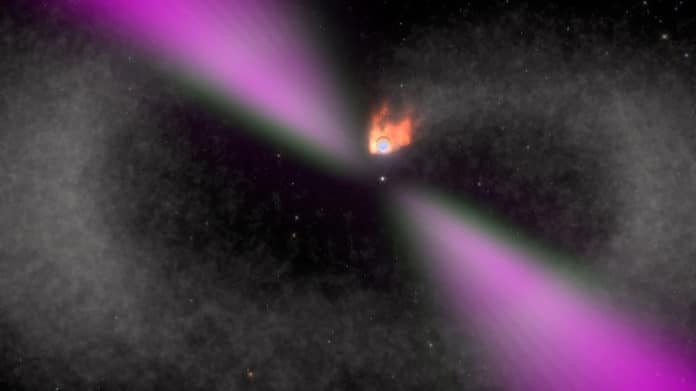Two dozen black widow binaries are known to exist in the Milky Way. MIT astronomers have identified a new black widow binary in our galaxy, located about 3,000 light-years from Earth. Known as ZTF J1406+1222, this new system has the shortest orbit yet identified, with the pulsar and companion star circling each other every 62 minutes.
ZTF J1406+1222 seems to be unique. It appears to host a third, far-flung star that orbits around the two inner stars every 10,000 years.
This likely triple black widow is raising questions about the formation of this system. According to the MIT team, it may have formed as the triple system in most of the black widow binaries arose from a globular cluster. This cluster may have drifted into the Milky Way’s core, where the gravity of the central black hole was enough to pull it apart while leaving the triple black widow intact.
Kevin Burdge, a Pappalardo Postdoctoral Fellow in MIT’s Department of Physics, said, “It’s a complicated birth scenario. This system has probably been floating around in the Milky Way for longer than the sun has been around.”
Most black widow binaries are found through the gamma and X-ray radiation emitted by the central pulsar. Scientists used a new approach to detect this system: visible light, and specifically the flashing from the binary’s companion star.
Burdge said, “This system is unique as far as black widows go because we found it with visible light and its wide companion. There’s still a lot we don’t understand about it. But we have a new way of looking for these systems in the sky.”
It turns out that the companion star’s dayside — the side perpetually facing the pulsar — can be many times hotter than its night side due to the constant high-energy radiation it receives from the pulsar.
Burdge explains, “I thought, instead of looking directly for the pulsar, try looking for the star that it’s cooking. If astronomers observed a star whose brightness was changing periodically by a huge amount, it would be a strong signal that it was in a binary with a pulsar.”
Scientists tested their theory by observing optical data taken by the Zwicky Transient Facility. They studied the brightness of stars to see whether any were changing dramatically by a factor of 10 or more on a timescale of about an hour or less — signs that indicate the presence of a companion star orbiting tightly around a pulsar.
Scientists validated their method accuracy after picking out the dozen known black widow binaries. They then spotted a star whose brightness changed by 13 every 62 minutes, indicating that it was likely part of a new black widow binary, which they labeled ZTF J1406+1222.
Burdge said, “The one thing we know for sure is that we see a star with a dayside that’s much hotter than the night side, orbiting around something every 62 minutes. Everything seems to point to it being a black widow binary. But there are a few weird things about it so that it may be something entirely new.”
The team plans to continue observing the new system, as well as apply the optical technique to illuminate more neutron stars and black widows in the sky.
Journal Reference:
- Burdge, K.B., Marsh, T.R., Fuller, J. et al. A 62-minute orbital period black widow binary in a wide hierarchical triple. Nature 605, 41–45 (2022). DOI: 10.1038/s41586-022-04551-1
